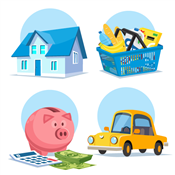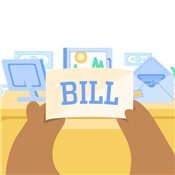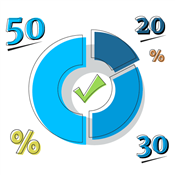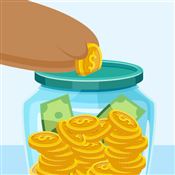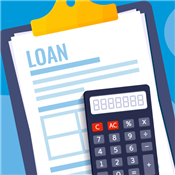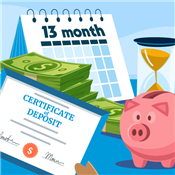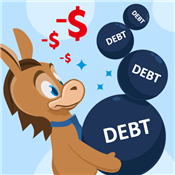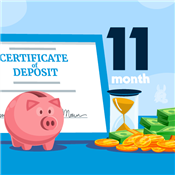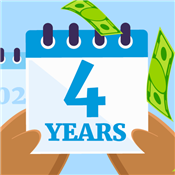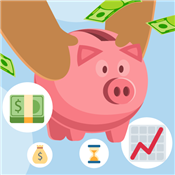Debt Snowball Calculator
A debt-free future is within your reach. Calculate how fast you'll pay off your debt with the debt snowball and debt avalanche methods.
 |
If you have multiple debts, it's easy to feel overwhelmed by all the payments.
But you can regain control with a debt repayment strategy called debt snowball.
In this guide, find out how debt snowball works and what you can do to break free from debt ASAP. Plus, learn the basics of debt and other debt repayment strategies to consider.
Calculate
Enter the extra amount you can pay each month.
Total debt:
Compare how long it will take for you to be debt-free using the three debt payment methods: Avalanche (highest interest first), Snowball (lowest amount first) and Minimal payment only
Verdict
With an extra payment of
- Using the snowball method you pay totally and you will be debt-free on
- Using the avalanche method you pay totally and you will be debt-free on
With no extra payment
- You pay totally and you will be debt-free after
Debt
What is the snowball effect for paying off debt?
Debt snowball is a method of paying off debt quickly and efficiently.
It involves paying off your balances from smallest to largest. As you pay off each debt, the payments you would have made to the paid-off debt get applied to your next biggest balance.
It's called "snowball" because your payments grow larger over time and your debt shrinks more quickly. Find out how it works in the step-by-step below.
How do I calculate my snowball debt?
Debt snowball is so appealing because it's easy to follow (and easy to stick to). Here's the step-by-step:
- First, list out all your debts with their balances, minimum payments, and interest rates.
- Then, make the minimum payment on all your balances except the smallest balance.
- On your smallest balance, pay extra so it can be paid off faster.
- Once it's paid off, pay extra on the next-smallest balance.
- Continue until all your debt is paid off.
With our calculator, you'll also see your Debt-free Date depending on which repayment strategy you choose: debt snowball, debt avalanche, and minimum payment only.
Debt avalanche is a modified version of debt snowball for those who are eager to pay off debt ASAP. Find out how debt avalanche differs from debt snowball in the section below.
Debt Snowball vs Debt Avalanche vs Minimum Payment Only
Both debt snowball and debt avalanche are repayment strategies that aim to pay off your debt quickly. Here's how they differ:
Debt snowball
Involves making extra payments on smallest balances first
- Easier to implement and stick to
- Takes slightly longer than debt avalanche
- Will incur more interest than debt avalanche
Who debt snowball is right for: Those who struggle to pay off debt, those with less discretionary income
Debt avalanche
Involves making extra payments on balances with the highest interest rates first
- More difficult to stick to
- Requires more money at any given time
- Pays off quicker
- Less money spent on interest
Who debt avalanche is right for: Disciplined debt-payers, those with more discretionary income, FIRE followers
Minimum payment only
Involves making only the minimum payments on all your debts
- Least expensive in the short-term
- Most expensive over time (more interest incurred)
- Takes longer to pay off all debt
Who minimum-payment-only is right for: No one, really. Even if you don't have a lot of money to spare, paying just a little extra each month is ideal.
Keys to Debt Repayment Success
Debt snowball and debt avalanche are good strategies for debt repayment. But they're not necessarily right for everybody. And they both require commitment.
Here's a few things to remember before participating in these debt repayment strategies.
- If you have irregular income, these may not be good options for you. Instead, consider the 50/30/20 budget to divvy up your income and pay off debt at a comfortable pace.
- Be mindful of 0% APR promotional periods. No matter your debt repayment strategy, any debt incurred during a 0% promo period needs to get paid off before that period ends.
- Be honest with yourself. Just because debt avalanche pays off faster, doesn't mean it's right for everyone. Think of it like a diet or exercise plan: you're more likely to stick to it if you find it easy to do.
- Pay an "extra" amount that you can afford. Look at your monthly budget to determine what you can afford to pay without straining your finances too much.
Debt Snowball & Repayment FAQs
How long does the snowball effect take?
The debt snowball method really starts to make a difference after your first balance is paid off.
Once you've moved on to make extra payments toward your next-smallest balance, you're likely to pay it off at a much faster pace.
Should you pay off your smallest debt first?
Those who struggle with discipline and need encouragement to keep going should pay off their smallest debt first.
After you see that balance paid off, you're more likely to stick with the debt snowball repayment method.
Does the debt snowball really work?
The debt snowball method really does work to pay off your debt at a good pace. Just keep in mind, you will still be incurring interest as you work your way through each balance.
If you have more discretionary income and want to avoid as much interest as possible, consider the debt avalanche method.
Should I save, invest, or pay off debt?
Paying down debt is important, but don't worry about having all your debt paid off before you start saving. If you run into an emergency, you'll want to pull from savings before using a credit card.
Once your debt is manageable and you've set aside a healthy savings, consider investing your money in a diversified portfolio.
Debt Glossary
If you're going to be paying off debt (which we all are), it pays to know how it works. Review these debt terms to understand how your debt affects your finances.
- Balance: The amount of money that you still owe the creditor.
- Principal: The amount of money you've borrowed, not including any interest you've incurred since borrowing it.
- Interest Rate: A percentage of your balance that the creditor charges you for borrowing money; is usually charged monthly or annually; paid on top of the principal.
- APR: Annual Percentage Rate; the annual rate that the creditor charges you for borrowing money.
- Minimum Payment: The lowest amount that the creditor requires you to pay toward your debt each pay period.
- Consumer debt: Debt incurred from making purchases as an individual consumer (instead of as a business or other entity); includes credit cards, auto loans, student loans, mortgages, personal loans, etc.
- Revolving debt: Any debt that lets you borrow from an established credit line; does not come with a set repayment date.
- Installment debt: Debt that has to be paid back in fixed amounts by a specific repayment date.
Bottom Line
Debt snowball and debt avalanche are both tried-and-true repayment strategies that eliminate debt more quickly than a minimum-payment-only approach. If you can afford to make extra payments toward your debt (on top of the minimum payments), it's definitely worth trying one of these two strategies.
Just remember, it takes discipline, organization, and commitment. It may be tough to put extra "fun" money toward debt, but just think about how relieved you'll be when that debt is gone!
Holly Zorbas is a assistant editor at CreditDonkey, a personal finance comparison and reviews website. Write to Holly Zorbas at holly.zorbas@creditdonkey.com. Follow us on Twitter and Facebook for our latest posts.
|
|
| ||||||
|
|
|

